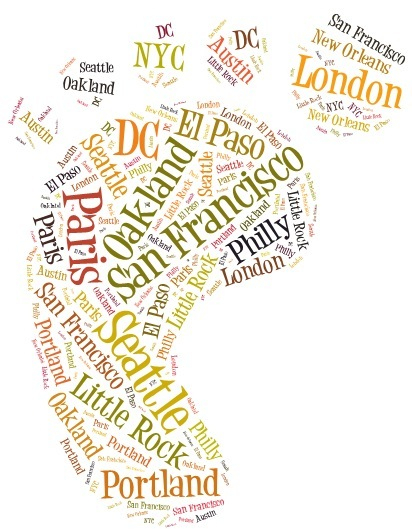 Vibrant LS User Groups are operating face-to-face and virtually both within and across organizations. They are emerging in multiple communities and within specific domains.
Vibrant LS User Groups are operating face-to-face and virtually both within and across organizations. They are emerging in multiple communities and within specific domains.
At last count, there were public groups gathering in 100+ cities. New groups are forming all the time. Every user group leader likes more participants: send a note to friend you think might enjoy a liberating group experience. A full list of user group contacts can be viewed here.
If you are interested in joining in the fun or starting your own, let us know! We would be thrilled to help you get started. Contact Keith, Fisher, or Anna.
Contacts & websites for user groups worldwide. For User Groups in Europe, see the map below this list. There are four online groups that attract participants from across regions:
- Austin, TX - Austin MeetUp
- Liberating Structures Go Online (international) MeetUp
- Berlin (DE) Sylvia Taylor Berlin MeetUp
- Washington DC - Lee Gimpel - Website
...
- Auckland, NZ - Monica Leon Wellington, NZ Susan Basterfield
- Bay Area (San Francisco/Oakland) Jim Best
- Beirut, Lebanon. Hicham Ghorayeb MeetUp Group
- Glasgow, Scotland - Kirsty Ellis
- Bellingham, WA - website Art Sherwood, David Westerlund
- Berlin (DE) Sylvia Taylor Berlin MeetUp
- Bangalore (IN) Nagesh Sharma
- Boston - Denise Easton
- Brussels, Belgium Brussels MeetUp
- Chennai (IN) Venkatesh Rajamani
- Chicago - Michael Herman
- China - Brenda Zhang (Brendazhang@UPerform.cn) & Eugene Cao (eugenecao@126.com). Here is a brief summary of the organizng work they've been doing to launch the LS User Community in China.
- Cracow, Poland - Meetup and contact
- DC - Lee Gimpel - Website
- Hamburg, DE - Johannes Schartau LS website in German
- Istanbul, Turkey - LinkedIn Group Ilkay Polat
- Leeds, UK Meetup – Sharon Dale
- Ireland - Juanita Guidera
- Little Rock, AR - Molly Miller
- Lodz, Poland, Pawel Lewinski Facebook group
- London sign up email list
- Madison,WI - Darin Harris
- Melbourne, AUS Contact Vanh Mixap Meetup link
- Montreal, Canada Facebook Group organized by Vienna Blum (Vb@mgtsavvy.com) and Pierre-Cyril Denant (denant.pierrecyril@gmail.com)
- New Delhi, India - Anu Sachev
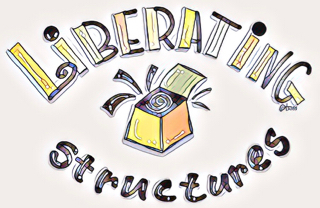
- NOLA - Amanda Buberger
- Ottawa, CA / Lanark County - Jane Torrance
- Paris, FR - Frederic de Verville [] : [] LS website resources en Francais
- Philadelphia - Bruce Waltuck Yes, and... Philly website
- Portland, OR - Lolo Halman
- Pullman, WA - Davi Kallman
- Sacramento - Natalie Campbell & Ashley Taylor
- San Luis Obispo, CA - Matt Roberts
- Seattle - Fisher Qua MeetUp website
- Sewanee, TN - Nicky Hamilton
- Toronto, CA - Liz Rykert MeetUp website
- Traverse City, MI Sarah Ely
- Vancouver, British Columbia - Leva Lee and Barish Golland (co-leaders)
- Ho Chi Minh City, Vietnam, Khoa Doan Tien (leader) Meetup and Facebook
- Warsaw, Poland Meetup and contact
- Wroclaw, Poland Meetup and contact
- Victoria, British Columbia - Facebook group led by Tracy Kelly and Beth Cougler Blom
More resources and support for getting started:
There's a #usergrouporganizing channel on Slack (http://bit.ly/lscommunityslack). People will offer gobs of support for specific questions you have. Anna Jackson and Fisher Qua coordinate an quarterly virtual Zoom session for User Group leaders. Add your name to this spreadsheet and you will be included in the next announcement.
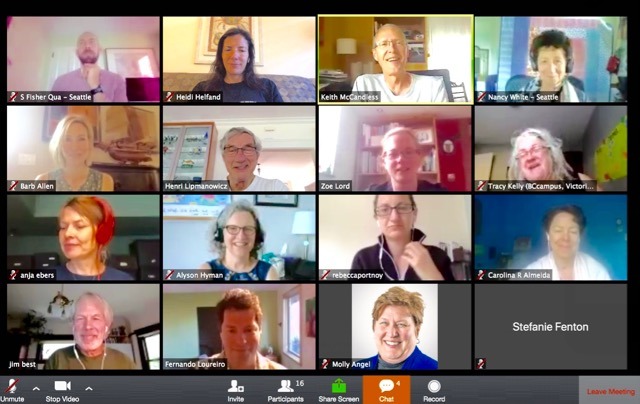 Zoom and other social platforms help connect far flung user group leaders
Zoom and other social platforms help connect far flung user group leaders
Read about how Johannes Schartau, LS user group leader in Hamburg Germany, is growing his local user group and helping a colleague (Sylvia) get another cooking in Berlin. It reflects perfectly our experience in developing the Seatllte user group. Hats off to Johannes.
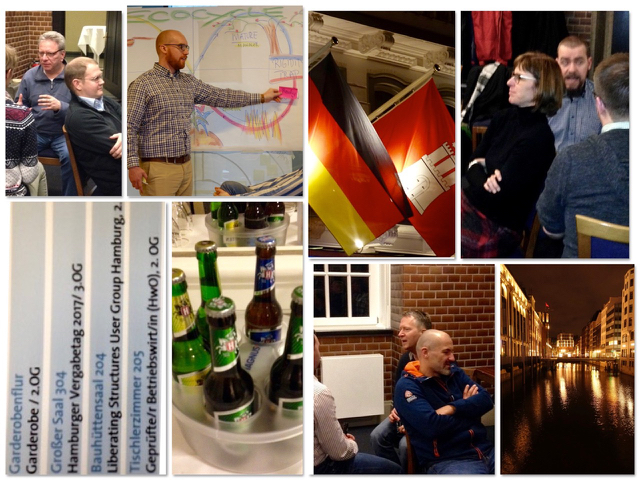 I had a chance to visit the Hamburg user group in January. Our theme was “expanding your repertoire.” Our string included Impromptu Networking, User Exp Fishbowl, Troika Consulting, Positive Gossip, and 25/10 Crowdsourcing. Johannes pictured in front of the Ecocycle.
I had a chance to visit the Hamburg user group in January. Our theme was “expanding your repertoire.” Our string included Impromptu Networking, User Exp Fishbowl, Troika Consulting, Positive Gossip, and 25/10 Crowdsourcing. Johannes pictured in front of the Ecocycle.
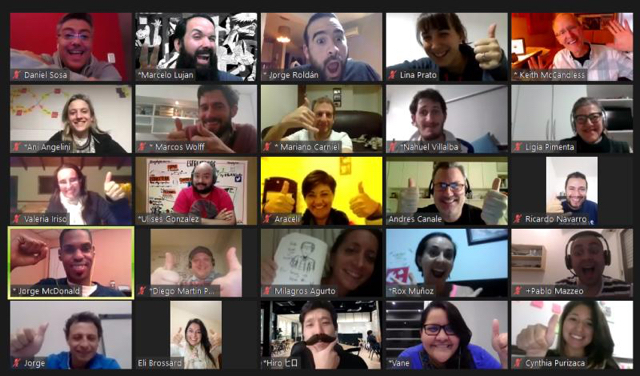 LS learning group composed of users across Latin America
LS learning group composed of users across Latin America
Seattle User Group Experience
In Seattle, we have monthly face-to-face meetings. We get together in downtown Seattle in organizations that donate the space. We have 440+ members signed up on MeetUp. Each 90-minute session includes three activities:
- networking among members
- getting & giving help
- learning or inventing something new together
 National Museum of the American Indian, "Raven Swallows the Sun"
National Museum of the American Indian, "Raven Swallows the Sun"
We rotate leadership and design responsibilities among the participants. Here is our design from August, 2013.
- NETWORKING: Connecting with people working in diverse domains and welcoming LS beginners into the mix via Impromptu Networking + Social Network Webbing (30 minutes)
- GETTING & GIVING HELP: Using Heard~Seen~Respected to respond empathetically to challenges without over-helping (30 minutes)
- LEARNING TOGETHER: Playing with Panarchy in order to spread new ideas across many levels simultaneously (30 minutes)
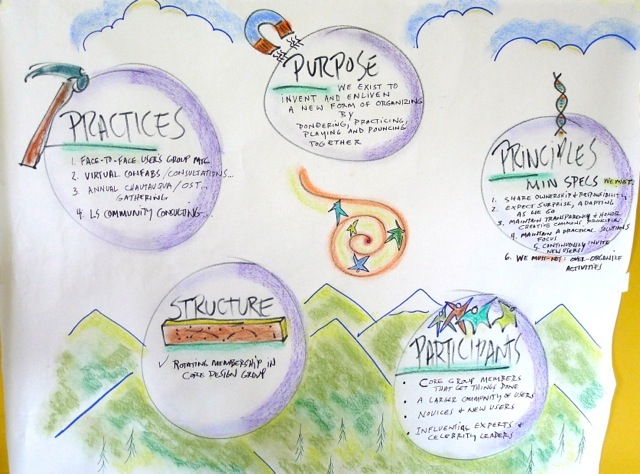 Purpose To Practice for the Seattle User Group (drawing by Keith)
Purpose To Practice for the Seattle User Group (drawing by Keith)
Above are visual notes from our first gathering. We did a rapid cycle Purpose-To-Practice together. The seriously fun purpose that emerged is:
We exist to invent and enliven a new form of organizing by pondering, practicing, playing, and pouncing together
The group is breathing air into four trial balloons (below). We will keep you updated on what floats or sinks.
- A monthly face-to-face evening together in Seattle featuring use of LS to advance learning;
- Occasional virtual confabs that include international users and special projects;
- An annual Chautauqua/Open Space shindig;
- And, a LS twist on the Community Consulting model to help new users get direct experience with complex challenges (low or no cost services are provided to organizations via an experienced LS consultant and a team of less-experienced people that want to learn).
Below are more details from our Purpose To Practice design session.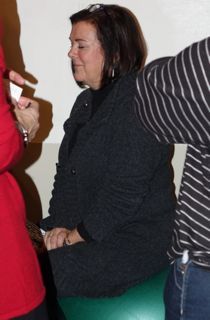 With eyes closed for better listening, LS user receiving a consultation via Wise Crowds
With eyes closed for better listening, LS user receiving a consultation via Wise Crowds
Purpose
Why this work is important to you and the larger community
We exist to invent and enliven a new form of organizing by pondering, practicing, playing, and pouncing together
Principles
The must do and must not do rules we must obey to achieve our purpose
- Users must share ownership of and responsibility for the group
- Users must expect surprise, adapting to opportunities and discoveries as they emerge
- Users must maintain transparency and honor Creative Commons principles
- Users must maintain a practical “solutions focus” to group activities
- Users must not over-organize activities
- Users must continuously invite and welcome new users and novices into the group
Participants
Who must be included to achieve our purpose
- Core group members (those to take responsibility for organizing activities)
- A larger community of LS users (local, regional, national, international users that participate in activities)
- Novices and new users (people invited to join activities by LS users)
- Influential experts and celebrity leaders not actively using LS
Structure
How will we organize (both macro- and microstructures) and distribute control in pursuit of purpose?
For now, Fisher and Keith will coordinate development activities. Leadership of meetings will rotate among user group members. MeetUp.com will be used to share and simplify interactions.
Practice
What are we going to do? What will we offer to our users/clients and how will we do it?
Four trial balloons are afloat:
- A monthly face-to-face evening together in Seattle featuring use of LS to advance learning;
- Occasional virtual confabs that include international users and special projects;
- An annual Chautauqua/Open Space shindig;
- And, a LS twist on the Community Consulting model to help new users get direct experience with complex challenges (low or no cost services are provided to organizations via an experienced LS consultant and a team of less-experienced people that want to learn)
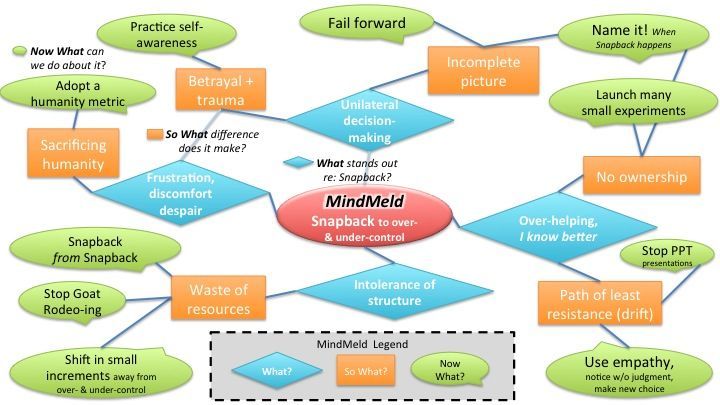 A MindMeld map generated at our October 2015 user group 3.9 meeting.
A MindMeld map generated at our October 2015 user group 3.9 meeting.
Our May 2018 meeting was led by Art Sherwood. We are designing 2018 meetings around the ten LS Principles. Art pulled together a brilliant string to bring Deep Respect for People and Local Solutions to life: Impromptu Networking, HSR, TRIZ, What 3X, and back to Impromptu Networking. His Design Storyboard here.
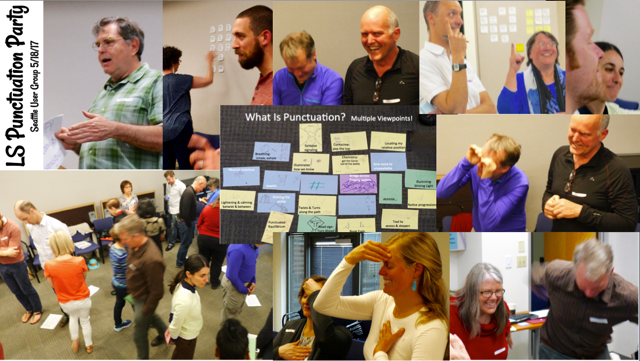 LS punctuation party in progress. Users see punctuation between LS as: priming the pump, musical notations, road signs, punctuated equilibrium, book ends, synapse signaling, and chemistry to get the genie out of the bottle! We put Anxiety Circus, Milling, Drawing Demons, Liquid Courage, and something new from Greg Myers into play.
LS punctuation party in progress. Users see punctuation between LS as: priming the pump, musical notations, road signs, punctuated equilibrium, book ends, synapse signaling, and chemistry to get the genie out of the bottle! We put Anxiety Circus, Milling, Drawing Demons, Liquid Courage, and something new from Greg Myers into play.
During user group meetings, we "field test" promising new microstructures. MindMeld makes all the observations, patterns, and action ideas visual for everyone to see. Our theme was "snapback or relapse to over- and under-controlling behaviors." 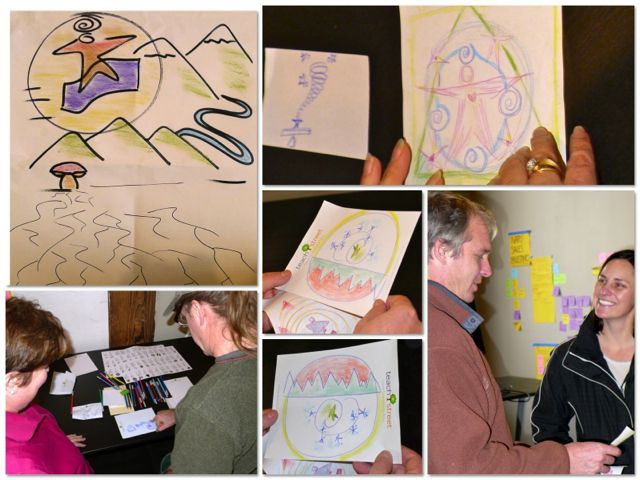
Stringing "Drawing Together" and "Impromptu Networking" to deepen introductions among user group participants. This is a very productive string.
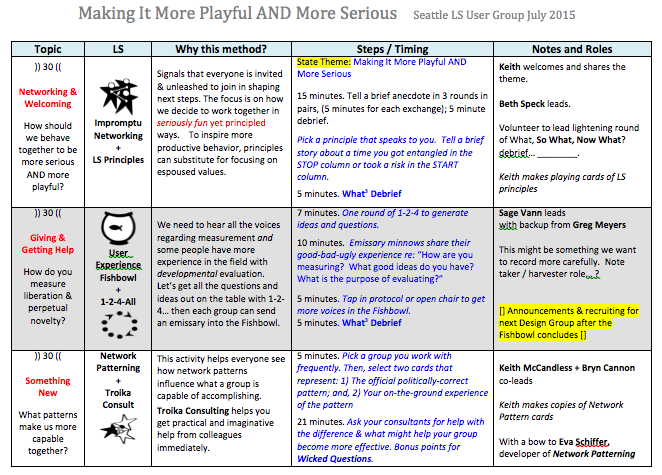
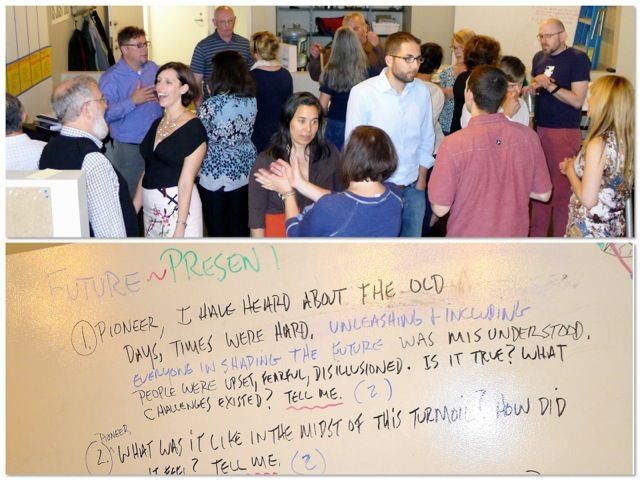 Seattle User Group prototyping Future~Present (June). We practice “failing forward” as new approaches are debuted. The goal of Future~Present is to “develop imaginative tactics for scaling up from local successes to a broad transformation."
Seattle User Group prototyping Future~Present (June). We practice “failing forward” as new approaches are debuted. The goal of Future~Present is to “develop imaginative tactics for scaling up from local successes to a broad transformation."
Design Storyboard for September user group meeting. Developed by Alex Dunne, Grace Wang, Fisher Qua, Keith McCandless). Many thanks to Fisher for creating the storyboard.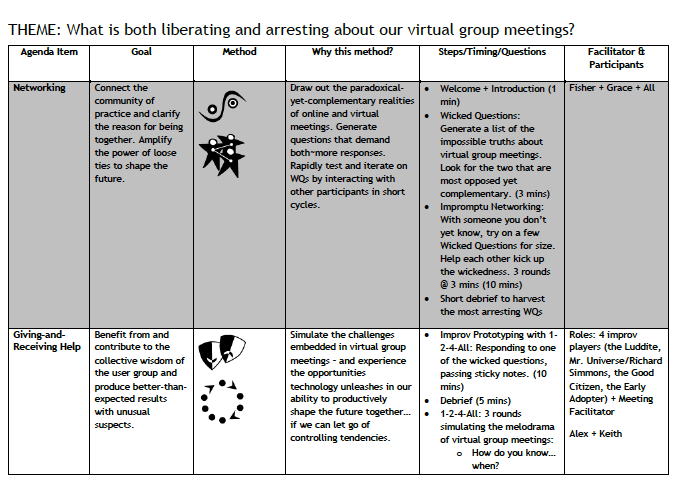
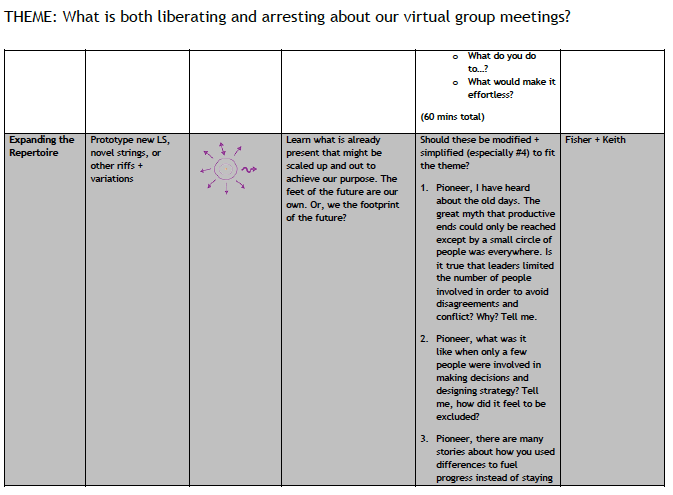 User Group members got a good start on Min Specs for bringing virtual meetings back to life.
User Group members got a good start on Min Specs for bringing virtual meetings back to life.
1. Distributing information must not be the purpose of convening a virtual meeting. Firmly invite participants read the material in advance--no ifs, ands, or buts. Stop the madness of long-boring-stifling-ineffective PPT presenatations.
2. Asking questions that invite participants to explore a shared challenge must be part of the virutual meeting purpose. For example, if the topic is "what can we do about poor employee engagement scores?," a set of productive questions could include: How do you know when people are not engaged? What do you do to maintain your own focus? How do you help others do the same? What makes it difficult to maintain a positive and engaged attitude? Do you know anyone or any group who is able to maintain high engagement consistently or effortlessly? How?? Are any good ideas coming to mind? Any 15% Solutions? What first steps could we take together? [Adapted from Discovery and Action Dialogue] This set of questions sparks both self-discovery and action to move forward together. Ahhhhh.
3. Contributing ideas must be very simple and safe for every participant.
Here is a helpful checklist for liberating a virtual meeting. A deep bow to Alex Dunne who got this snowball rolling!
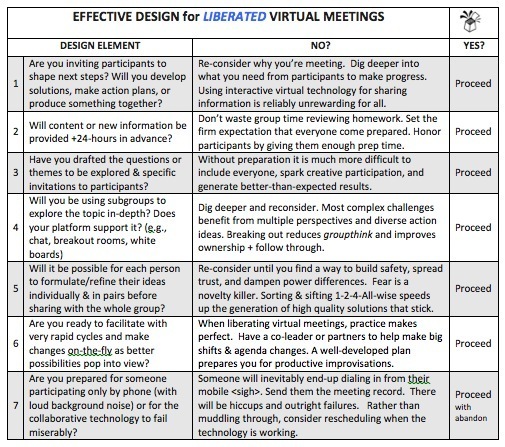
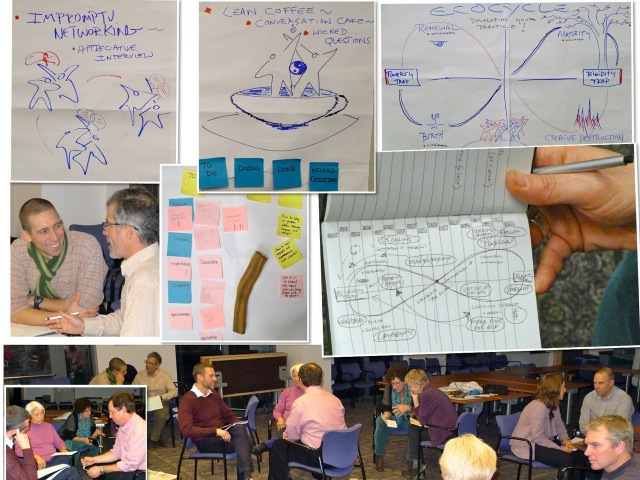
The first meeting of 2015 (January 15) featured a twist on Lean Coffee. Fisher invited the group of 20 individuals to pose a question they had about using LS.
Questions were jotted down on a post-it note and placed on the wall. [see photo below] Each participant had three votes to prioritize which questions to tackle first, second, third.... With the top question in mind, 1-2-4-All was employed to generate ideas and answers [10 minutes] Then, for the second question pulled out of the "Fish in the Sea" backlog, we employed Wise Crowds/Caravan [two rounds, 12 minutes]. You get the idea behind this progression.
The interaction was deeper, faster, and more productive than anyone expected. We loved it. A very successful first prototype! Bravo to the design team--Fisher Qua, Alex Dunne, and Jeff Carter.
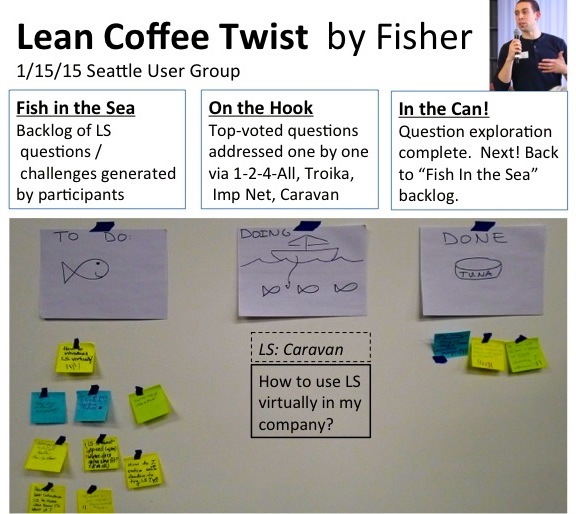
Our March 19, 2015 meeting theme was: reaching across scales (up, down, and out) to spread an innovation. Below are artifacts from each of three parts of our gathering. Reconnectiong; Getting and Giving Help; and, Trying or Developing Something New.
Mad Tea Party questions developed by Richard Gelb (lightly edited by Keith).
1. I know an innovation is diffusing across scales when I see…
2. I guide constructive disruption across scales when I...
3. I help lift great thinking across scales when I…
4. I’m seeing things get lost in translation across scales when…
5. The challenge in coordinating between the whole and the parts is…
6. Cultural aspects of working across scales includes…
7. For me, better working across scales means…
8. I can better connect the whole and parts by…
9. One trick about using Liberating Structures across scales is…
10. Something I can do better in facilitating between large and small group interactions is…
11. When there are significant power differences among participants, a LS or approach I will try is…
12. A unique opportunity I have for creative scale jumping is…
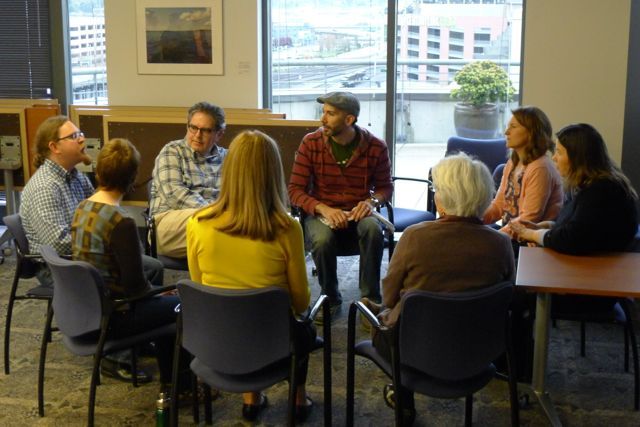 One of three DAD dialogues underway with volunteer facilitators and “butterfly catchers” studying at the feet of LS users.
One of three DAD dialogues underway with volunteer facilitators and “butterfly catchers” studying at the feet of LS users.
Immediately following Mad Tea, we constructed a set of Discovery and Action Dialogue (DAD) questions and formed three groups to explore the challenge of reaching across scales. Here are the questions:
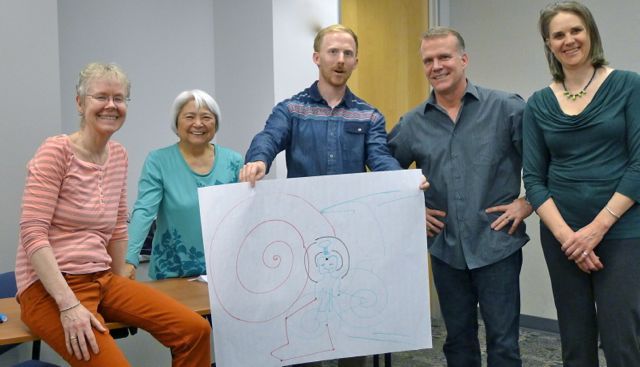 A happy group showing off their collaborative drawing, It illustrates a rhizome-inspired structure in which each of us can have influence.
A happy group showing off their collaborative drawing, It illustrates a rhizome-inspired structure in which each of us can have influence. Magda Kaspary led the "try something new" section. She introduced Rhizomatic Action, a LS in development.
In a three part activity, participants were invited: 1) to draw a themselves in a conventional structure, and then share how they feel via a 1-2-4-All; after a short description of how rhizomes structure themselves, to draw a structure in which they could have influence; and, 3) to join together in a group to create a collaborative drawing. See above.
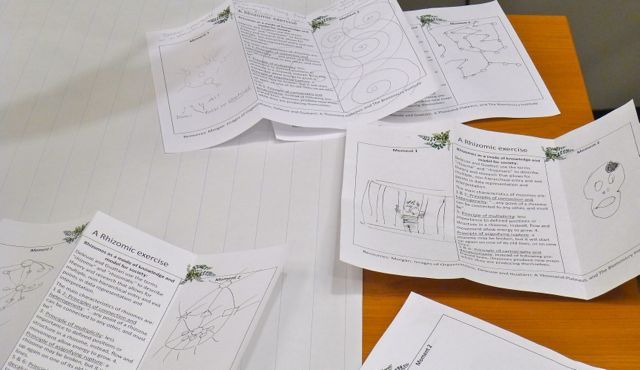 A clever three-fold worksheet was employed to capture conventional and rhizome-inspired drawings by participants.
A clever three-fold worksheet was employed to capture conventional and rhizome-inspired drawings by participants.
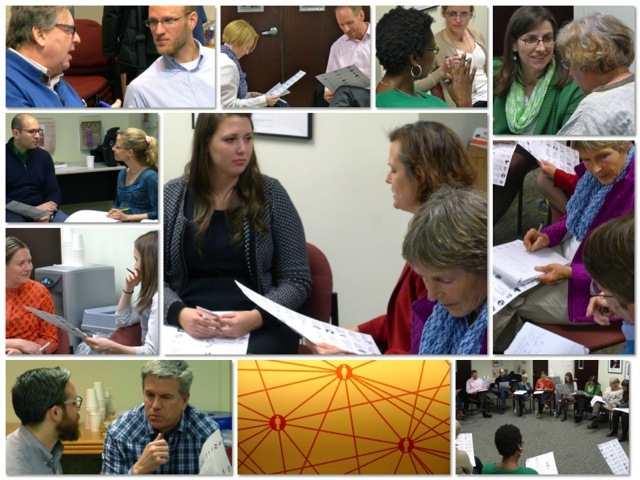
21 members of the DC LS User Group showed up on April 1. No foolin’. Keith McCandless shared LS innovations developed in other user groups. We danced a lively LS string together: Liquid Courage, Critical Uncertainties, LS Selection Matchmaker, and Social Network Webbing. A bow to group leaders Erin Stock and Mara D’Amico.
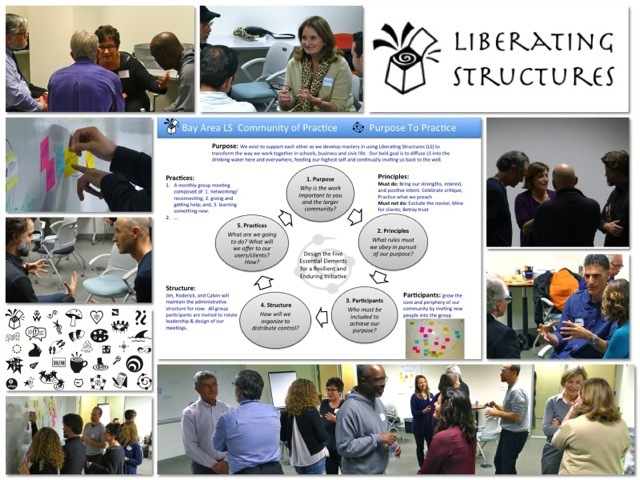
Bay Area LS community launch meeting underway (January 29, 2015). Hosted by Saybrook University. 30 participants from business, education, NGOs, healthcare, and government engaged in a lively and productive cycle of P2P. Can you say “liftoff?”
Virtual Groups Tracy Kelly and colleagues are rigorously experimenting with LS online. Check out “how to host” a Mad Tea Party here.
Tracy Kelly and colleagues are rigorously experimenting with LS online. Check out “how to host” a Mad Tea Party here.
Field stories and challenges are being actively shared both on the Liberating Structures website and in real-time on the LinkedIn group and a LS Facebook page. Many user groups (Seattle, Austin, Portland, Bay Area, Paris, London, Hamburg) are starting to use MeetUp.com to organize meetings and share insights.
Virtual group LS application leaders include Keith McCandless, Denise Easton, Nancy White, Tracy Kelly, and Liz Rykert. One example of a virtual LS use with a group of 30 ODN members can be viewed here [AdobeConnect ODN webinar]. Also, check out the "Liberating Virtual Meetings" heuristcs at the bottom of this page.
If you are interested in inventing or vetting new LS, go to LS in Development. Join in the action and discover how LS are continuing to deliver results at the front lines.
